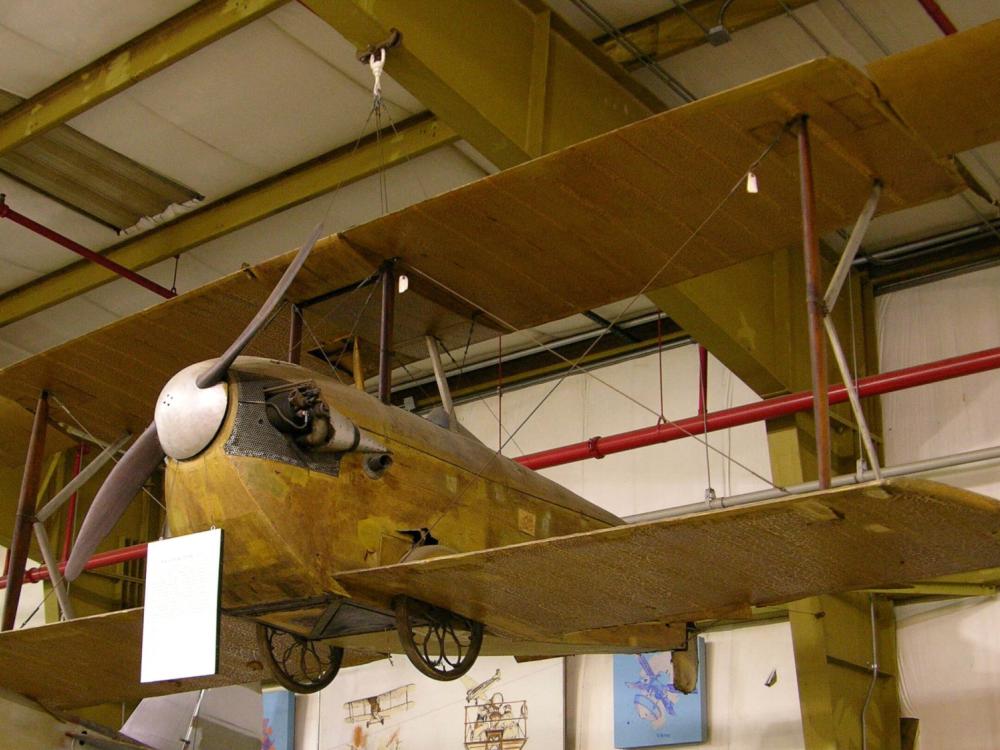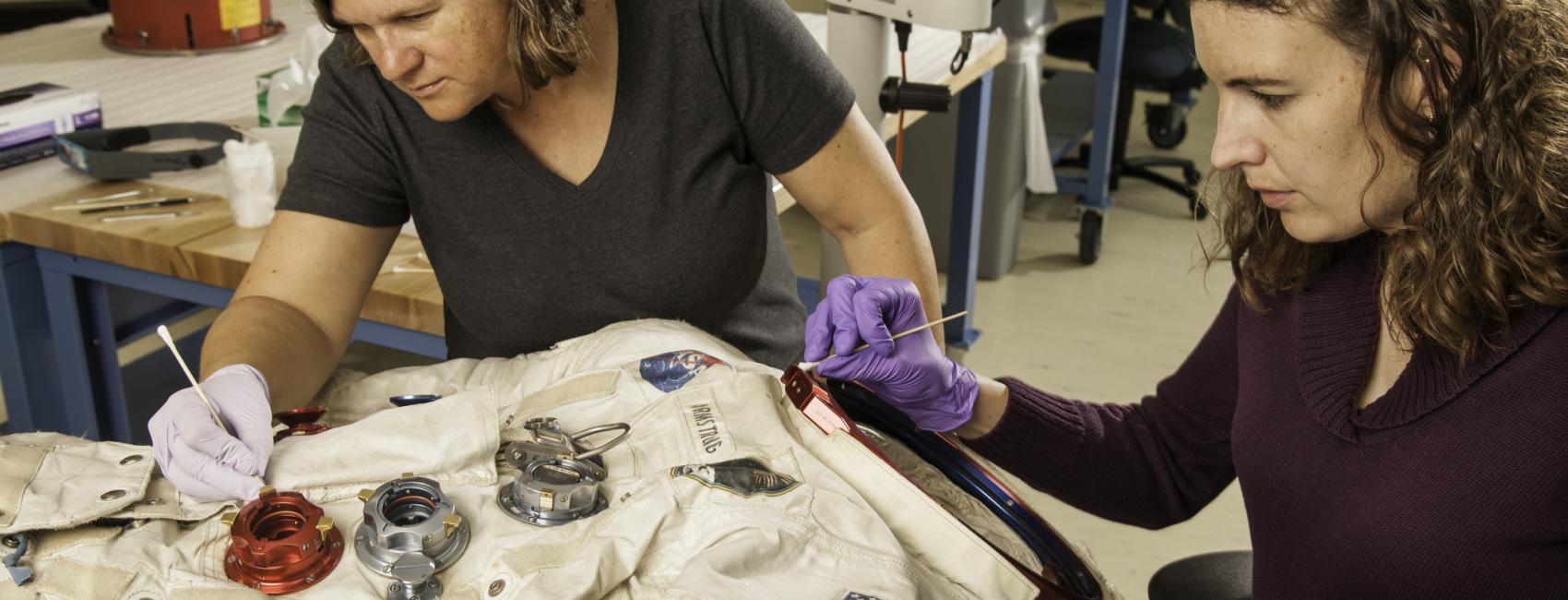
The Martin K-III Kitten
Aug 09, 2024
By Sean Seyer

Aug 09, 2024
By Sean Seyer
A curious little aircraft hangs from the ceiling of Building 24 of the National Air and Space Museum’s Paul E. Garber Facility in Suitland, Maryland. Known as the Martin K-III Kitten, this one-of-kind, experimental World War I era single-seat scout biplane incorporated three novel devices: a K-bar strut connecting the top and bottom wings, an aeronautical stabilizing device at the outer tips of the top wing, and a retractable chassis (a square frame with a cross bar that partially retracted the K-III’s wheels into the aircraft to reduce parasitic wind resistance).
When the K-III’s designer James Vernon Martin offered the diminutive aircraft to the Smithsonian Institution’s National Museum in 1924, he presented it as “the first aeroplane in the entire world to incorporate the retractable chassis.” More importantly for Martin, the K-III also represented one of the few examples of aircraft produced by aviation pioneers like himself that he claimed had been the victims of an “Aircraft Conspiracy” to monopolize the industry at the expense of so-called independents.
Practically unknown today, Martin’s persistent charges of conspiracy shaped how the public and Congress viewed the emerging aviation industry in the interwar period. His claim to have invented the retractable chassis served as the primary cornerstone of his conspiratorial frame. Martin secured three patents for his type of retractable chassis between 1919 and 1922, but the idea of retractable wheels on aircraft was not new. Numerous prior patents existed—such as an 1876 French patent strikingly similar to Martin’s patents—and the 1911 Curtiss Triad was the first aircraft to utilize retractable wheels. Nevertheless, Martin asserted that his patent constituted a basic one applicable to all possible mechanical variations of retractable landing gear. This stance placed him at odds with aircraft designers Alfred Verville, Grover Loening, and others who were working on their own distinct approaches for the U.S. government in the years after World War I.
Martin and engineer Flavius E. Loudy began work on a retractable chassis in Windsor, Ontario, in 1916. The next year, Martin visited the Royal Naval Air Service experimental station at the Isle of Grain in England, where he no doubt saw the diminutive P.V.7 “Grain Kitten,” a single seat scout aircraft that, along with its sibling the P.V.8, had been designed to combat the German Zeppelin threat. He soon secured permission from the British government to use a 45-horsepower ABC Gnat engine and modify the P.V.7 to include several of his patent-pending “efficiency devices.” By April 1917, Martin’s retractable chassis work had shifted to Elyria, Ohio, where he had partnered with the Garford Manufacturing Company for the construction of an experimental bomber under a $50,000 contract with the Air Service.
Continued production delays on his contracted bomber soon earned him a reputation as someone who could not deliver on his grand ideas. But rather than put his full attention into its completion, Martin badgered officers at McCook Field for an additional contract for the K-III. Chief of the Air Service’s Engineering Division Capt. Virginius E. Clark was unwilling to throw more money at a designer who had not yet proven himself. A. L. Garford nevertheless built the K-III to demonstrate Martin’s abilities in the hope of securing future contracts. After disappointing tests of the bomber’s experimental transmission at McCook Field in the spring of 1919, officers of the Engineering Division determined that the work needed to bring it to an operational standard was simply not worth the cost.
Rebuffed on his bomber, Martin refused to let the K-III undergo the Engineering Division’s prerequisite standard sandbag stress testing prior to an official flight test at McCook Field. The K-III nevertheless underwent a series of unofficial tests at the Hills and Dales Country Club in Dayton that summer. W. F. Gerhardt, the K-III’s pilot, determined that the aircraft would need a “complete redesign” before it could become a viable military machine. Loudy, who acted as observer, later testified that the K-III made about 15 “long hops,” the highest of which reached no more than 10 feet off the ground. Most importantly, the position of the retractable landing gear was always set on the ground before each flight and remained unchanged while the K-III was in the air. Martin’s subsequent claims that the K-III was the first aircraft to utilize a retractable chassis in flight simply did not reflect reality. Martin himself never flew the K-III or even observed these test flights. At the time of the tests he was serving aboard the Lake Fray as part of the U.S. Shipping Board’s efforts to provide relief to war-torn Europe.
In 1920, Martin offered the U.S. government a non-exclusive license to his primary retractable landing gear patent for one dollar. Although acceptance of his offer would not provide Martin with an immediate economic benefit, it would support his claim to have invented the retractable chassis and prevent the government from challenging his patent. Engineering Division contracting officer and future president of Consolidated Aircraft Corporation Capt. Reuben H. Fleet initially accepted Martin’s offer, but it was soon rejected after an Air Service Patent Division investigation raised questions about the patent’s validity. Martin interpreted the subsequent awarding of a contract for three experimental XPS-1 alert-type aircraft to the Dayton-Wright Company as proof of collusion to steal his invention, despite the fact that these machines incorporated a distinctly different streamlined retractable landing gear arrangement.
Martin’s sensational charges that the Air Service actively worked to suppress his supposedly superior invention while supporting the derivative work of his competitors became the central impetus behind an unsuccessful $51,510,000 conspiracy lawsuit in the Supreme Court of the District of Columbia in 1923. His charges were echoed on the floor of Congress in 1924, prompting investigations that led to the passage of the Air Corps Act, the Naval Aviation Act, and the Air Commerce Act in 1926. They also shaped congressional investigations into the air mail and patent pools during President Franklin D. Roosevelt’s first administration and formed the basis for a series of patent infringement lawsuits Martin brought against aircraft manufacturers, airlines, and the U.S. government that continued throughout the 1930s.
The K-III’s donation to the Smithsonian was a primary element in Martin’s strategy, and he regularly referenced the machine’s presence at the National Museum in both congressional and court testimony. But the label crafted by future head curator of the National Air Museum Paul Garber did not go as far as Martin would have liked, and instead simply stated that the K-III’s landing gear “may be drawn up in flight.” In 1940, a ruling in one of Martin’s lawsuits invalidated his retractable chassis patents based on prior art. Yet two decades of constant charges by Martin and his allies that a corrupt relationship existed among American aircraft manufacturers and military procurement officers had shrouded the aviation industry in an aura of illegality. Although the K-III was not the first aircraft to incorporate retractable landing gear, it does represent the embodiment of a conspiratorial counternarrative that shaped the development of American aviation just as much, if not more so, than any technological “first.”
Sean Seyer is an Associate Professor of History at the University of Kansas. He is the author of Sovereign Skies: The Origins of American Civil Aviation Policy (John Hopkins University Press, 2021) and the 2023-2024 Verville Fellow at the Smithsonian National Air and Space Museum. His current book project looks at how persistent charges of monopoly shaped American aviation policy in the first half of the twentieth century.

We rely on the generous support of donors, sponsors, members, and other benefactors to share the history and impact of aviation and spaceflight, educate the public, and inspire future generations. With your help, we can continue to preserve and safeguard the world’s most comprehensive collection of artifacts representing the great achievements of flight and space exploration.
We rely on the generous support of donors, sponsors, members, and other benefactors to share the history and impact of aviation and spaceflight, educate the public, and inspire future generations. With your help, we can continue to preserve and safeguard the world’s most comprehensive collection of artifacts representing the great achievements of flight and space exploration.